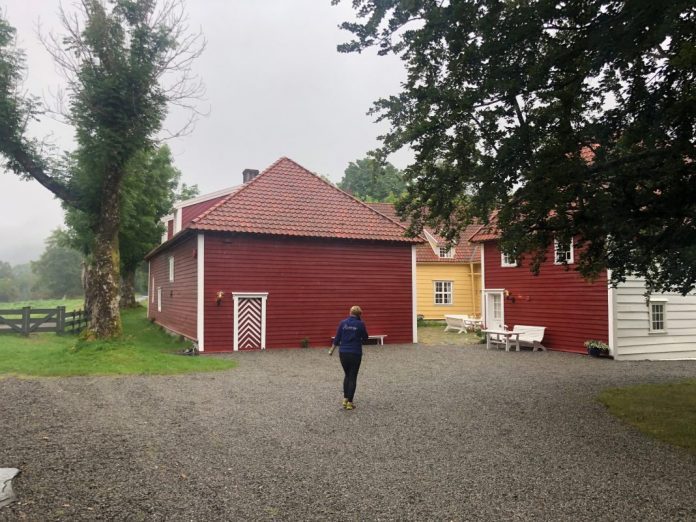After being a place for Danish noblemen, the Svanøy Hovedgård estate played a key role in the Norwegian salmon farming industry’s infancy.
“I came straight from middle school, in 1979, and got a summer job at the Svanøy Foundation. Most people had to leave Svanøy to get a job, so I was very happy,” said Elin Tveit Sveen.
She was one of several young farm hands who worked there and later received a salmon licence.
“We applied in 1985 and got a licence in 1986,” she said.
This laid the groundwork for salmon farmer Marø Havbruk, which currently has two licences.
Lush
It was not obvious that Svanøy, in the far south of Flora municipality, Western Norway, would become a knowledge bank for the growing Norwegian aquaculture industry. For in the decades after World War II, the lush island was marked by recession and displacement.
That was going to change. Thanks to a key person.
Christian Sommerfelt was managing director of Christiania Spigerverk’s hydroelectric facility in Svelgen. He flew one day over Svanøy with his seaplane. There he saw the stately main farm, which was in a state of decay.

Sommerfelt was president of the Norwegian Association of Industry and chairman of the Norwegian Export Council and had a large network of contacts. He brought with him research institutions and some rich friends in Oslo, raised around EUR 1 million and established the Svanøy Foundation.
With the money, they would restore the main farm and develop rural industries here. The later salmon diplomat Per Dag Iversen – in charge of diplomacy, foreign affairs, contact with Brussels – was engaged to build fish farms for salmon and trout.
Cultural heritage
The foundation took over, by agreement with the owner Kristoffer Svanøe, the main building and surrounding buildings in 1972.
With the purchase came a rich cultural-historical heritage.
In the time of Danish colonial rule, the regional tax collector was seated here. Originally called the estate Bru, but in 1685 it was renamed Svane Hovedgaard, after Copenhagen’s Archbishop Hans Svane.

During the Napoleonic Wars, Danish colonial power wavered. There were also changes to Svanøy. The preacher Hans Nielsen Hauge bought the farm for 12,000 riksdaler – a unit of currency used in Norway until 1816 and in Denmark until 1873 – in 1804.
The Haugians turned the site into a state of the art farm. They built mills, boat builders and salt boilers. They also made copper mines with the company Svanø Gruber.
However, in line with falling metal prices after World War I, mining investment was reduced. With that, investment and industrial activity went down. And the main farm decayed.

Industries
This is what Christian Sommerfelt wanted to do something about, and together with the board of the foundation, he highlighted a number of priority areas for rural industries.
They tested the breeding of capercaillie, snails, lobster, deer, goose and duck. But also farmed salmon and trout.

The fish farm on Langøya, west of Svanøy, was one of the first in the country. In particular, the work on farming and genetics was central. The Institute of Marine Research had all its breeding groups and salmon strains on Svanøy from 1974 to 1979. The research station for fish at Sunndalsøra (today known as Nofima) used Svanøy as a test station for its farming groups on both salmon and trout for 11 years from 1976.
The visionary work on salmon and trout farming attracted great interest, not least from the new generation. Among those who worked as farmhands, and gained knowledge, at the Svanøy Foundation were names such as Ola Braanaas, Alex Vassbotten (whose company is called Bru Eigedom) and Alf Helge Aarskog.

However, the fish farming initiative would soon face both biological and commercial challenges.
“We got furunculosis around the same time that went FOS went bankrupt. Both Alf Helge and I had to dig out dead fish at the time, reminisced Elin Tveit Sveen.
“We had significant outstanding receivables during the FOS bankruptcy in 1991. Thanks to a local savings bank that had faith in us, we salvaged ourselves through the crisis,” he added.
Fiskeoppdretternes Salgslag (FOS), was a sales monopoly on Norwegian salmon.
Too much
It eventually became too much and the foundation threw the towel in.
Fish farming was separated from the Foundation’s other activities, and the limited company Svanøy Havbruk was established. Over the years, this company has had several owners, including Fjord Seafood, which is now part of Mowi. When they eventually decided to close their aquaculture business at Svanøy, a new limited company, of the same name, was established after Ove Inge Vågen and Ola Sveen in 2005 brought in local investors.
The impression on those that worked on Svanøy apparently stayed with them. Alf Helge Aarskog has since bought a cabin here.

He has also entered the ownership side of the local store, together with Marø Havbruk and Svanøy Havbruk.
The deer farm is still here. But Svanøy Hovedgård does not run fish farming anymore today. Now the estate has been converted into a conference centre. This summer they have also, with great luck, run summer hotels and bistros on the old main farm. Next summer, they also hope to be able to host outdoor concerts again.


